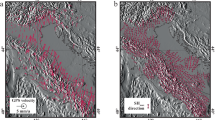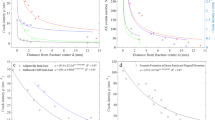Abstract
Earthquakes may be characterized after the event by several physical parameters, including the linear dimension of the fault, l, and the stress drop, p. Although the direct measurement of these parameters is often difficult, there are data on the frequency distribution of l and p for certain series of earthquakes (refs 1–11; C. Archambeau, unpublished data; personal communications from T. Mikumo, T. Utsu and R. I. Archuleta). For p there is evidence12–14 that the frequency distribution N(p) is given by a relationship of the form log N (p) = c1−(1−α) log p (1) where c1 and α are constants (α lying between 0 and 1) and N (p) dp is the number of stress drop in the range p to p + dp and p1<p<p2(p1>0, where p2 is limited). We report here that a relationship of this type holds (with specific parameters cl and α) for 15 different sets of earthquake occurring in Japan, California, Mexico, Nevada, Italy and the Aleutian arc. We also show that the frequency distribution N(p) provides some information about the frequency distribution of ground acceleration during earthquakes.
This is a preview of subscription content, access via your institution
Access options
Subscribe to this journal
Receive 51 print issues and online access
$199.00 per year
only $3.90 per issue
Buy this article
- Purchase on Springer Link
- Instant access to full article PDF
Prices may be subject to local taxes which are calculated during checkout
Similar content being viewed by others
References
Adair, R., Brune, J. N. & Orcutt, J. Earthquake Not. 49, 4 (1978).
Bakun, W. H., Bufe, G. C. & Stewart, R. M. Bull. seism. Soc. Am. 66, 363 (1976).
Sommerville, M. R., Peppin, W. A. & Van Wormer, J. R. Bull. seism. Soc. Am. 70, 1547 (1980).
Fletcher, J. B. Bull. seism. Soc. Am. 70, 735 (1980).
Hartzell, S. H. & Brune, J. N. Pageophysics 115, 333 (1977).
Lee, W. H. K., Herd, D. G., Cagnetti, V., Bakun, W. H. & Rapport, A. U.S. geol. Surv. Open File Rep. 79, 1621 (1979).
Munguia, L. et al. Geofis. Int. 17, 359 (1978).
Munguia, L. et al. EOS 59, 1131 (1978).
Peppin, W. A. & Bufe, C. Bull. seism. Soc. Am. 70, 269 (1980).
Tatcher, A. & Hanks, T. C. J. geophys. Res. 78, 8547 (1973).
Tucker, B. E. & Brune, J. N. Geol. Geophys. Stud. 3, 65 (1973).
Caputo, M. Ann. Geofis. 4, 277 (1976).
Caputo, M. & Console, R. Tectonophysics 67, T13 (1980).
Caputo, M. Tectonophysics 69, T9 (1980).
Brune, J. N. J. geophys. Res. 75, 4997 (1970).
Hanks, T. C. J. geophys. Res. 84, 2235 (1979).
Mcguire, R. K. & Hanks, T. C. Bull. seism. Soc. Am. 5, 70 1910 (1980).
Epstein, B. & Lomnitz, C. Nature 211, 1197 (1966).
Bernreuter, D. L. OECD-NEA/CSNI Rep. No. 28, 2, 429 (1979).
Author information
Authors and Affiliations
Rights and permissions
About this article
Cite this article
Caputo, M. Earthquake-induced ground acceleration. Nature 291, 51–53 (1981). https://doi.org/10.1038/291051a0
Received:
Accepted:
Issue Date:
DOI: https://doi.org/10.1038/291051a0
Comments
By submitting a comment you agree to abide by our Terms and Community Guidelines. If you find something abusive or that does not comply with our terms or guidelines please flag it as inappropriate.



